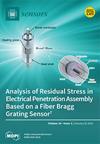Recent Innovations in Footwear and the Role of Smart Footwear in Healthcare—A Survey
IF 3.4
3区 综合性期刊
Q2 CHEMISTRY, ANALYTICAL
引用次数: 0
Abstract
Smart shoes have ushered in a new era of personalised health monitoring and assistive technologies. Smart shoes leverage technologies such as Bluetooth for data collection and wireless transmission, and incorporate features such as GPS tracking, obstacle detection, and fitness tracking. As the 2010s unfolded, the smart shoe landscape diversified and advanced rapidly, driven by sensor technology enhancements and smartphones’ ubiquity. Shoes have begun incorporating accelerometers, gyroscopes, and pressure sensors, significantly improving the accuracy of data collection and enabling functionalities such as gait analysis. The healthcare sector has recognised the potential of smart shoes, leading to innovations such as shoes designed to monitor diabetic foot ulcers, track rehabilitation progress, and detect falls among older people, thus expanding their application beyond fitness into medical monitoring. This article provides an overview of the current state of smart shoe technology, highlighting the integration of advanced sensors for health monitoring, energy harvesting, assistive features for the visually impaired, and deep learning for data analysis. This study discusses the potential of smart footwear in medical applications, particularly for patients with diabetes, and the ongoing research in this field. Current footwear challenges are also discussed, including complex construction, poor fit, comfort, and high cost.鞋类的最新创新和智能鞋在医疗保健中的作用--一项调查
智能鞋开创了个性化健康监测和辅助技术的新时代。智能鞋利用蓝牙等技术进行数据收集和无线传输,并具有 GPS 跟踪、障碍物检测和健身跟踪等功能。进入 2010 年代后,在传感器技术提升和智能手机普及的推动下,智能鞋领域迅速发展并呈现多样化趋势。鞋子开始采用加速计、陀螺仪和压力传感器,大大提高了数据收集的准确性,并实现了步态分析等功能。医疗保健领域已经认识到智能鞋的潜力,从而出现了一些创新产品,如用于监测糖尿病足溃疡、跟踪康复进展和检测老年人跌倒的鞋,从而将智能鞋的应用范围从健身扩展到医疗监测。本文概述了智能鞋技术的现状,重点介绍了用于健康监测的先进传感器、能量采集、视障人士辅助功能以及用于数据分析的深度学习的集成。本研究讨论了智能鞋在医疗应用方面的潜力,特别是对糖尿病患者的应用,以及该领域正在进行的研究。本研究还讨论了当前鞋类面临的挑战,包括复杂的结构、不合脚、不舒适和高成本。
本文章由计算机程序翻译,如有差异,请以英文原文为准。
求助全文
约1分钟内获得全文
求助全文
来源期刊

Sensors
工程技术-电化学
CiteScore
7.30
自引率
12.80%
发文量
8430
审稿时长
1.7 months
期刊介绍:
Sensors (ISSN 1424-8220) provides an advanced forum for the science and technology of sensors and biosensors. It publishes reviews (including comprehensive reviews on the complete sensors products), regular research papers and short notes. Our aim is to encourage scientists to publish their experimental and theoretical results in as much detail as possible. There is no restriction on the length of the papers. The full experimental details must be provided so that the results can be reproduced.
 求助内容:
求助内容: 应助结果提醒方式:
应助结果提醒方式:


